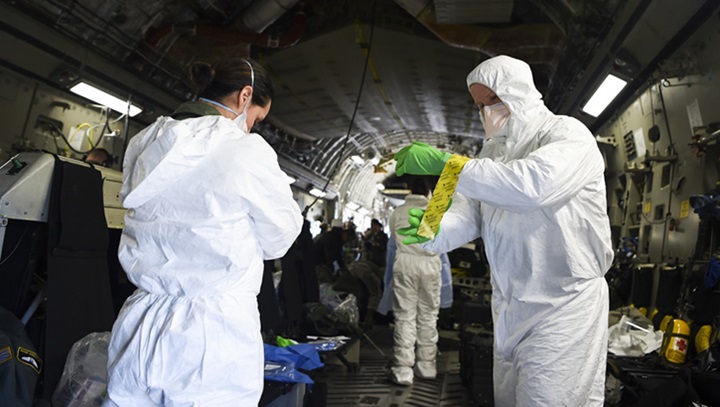The Politics Of Disaster Relief
After a 7.0 magnitude earthquake struck Haiti, the aftershock reached China in ways that few anticipated.The earthquake forced Chinese leaders to navigate the tricky politics of disaster relief.
A Daily Publication of The Dialogue
Some analysts in Brazil have revised down their economic forecasts in light of the coronavirus epidemic that started in China, as the fast-spreading illness’ potential effects on global trade and supply chains sparked concerns. Meanwhile, commodity prices have been volatile, leaving exporting countries of Latin America wondering what they stand to lose, or gain, as a result of increasing global disruptions. How serious is the risk of the coronavirus spreading to Latin America and the Caribbean? What will be the disease’s global economic fallout, and how will such trends affect Latin American and Caribbean economies? Which sectors in the region could be hurt the most, and which industries might benefit from the trade disruptions?
Fiona Mackie, regional director for Latin America and the Caribbean at The Economist Intelligence Unit: “Although there is still a lot of uncertainty around the eventual path of the coronavirus, there is clear evidence already of an impact on emerging market financial markets and on commodities that will transmit rapidly to Latin America, and especially South America’s large commodity exporters. There will be a direct impact from reduced trade with China, and the region’s open economies that export a lot to China will be particularly vulnerable here. There will be indirect impacts too from commodity prices, exchange-rate movements and the uncertainty effect on global business investment. All this raises questions as to how much policy space Latin America has to support growth in the near term. Most Latin American economies are in monetary easing mode, but coronavirus-related currency weakening could now complicate monetary policy. Space for fiscal stimulus will be even more limited. The relatively good news is that, based on our provisional baseline scenario for the spread of the coronavirus in China (which assumes the outbreak comes under control by end-March), we expect a recovery in China’s import demand and in commodity prices in the second half of 2020. On this basis, although we expect first-quarter data to be very weak, significant downward revisions to our GDP growth forecasts are likely to be limited to countries most exposed to commodity prices and to demand from China, including Chile and Peru. In Brazil, for example, we have for now revised down our 2020 growth forecast by only 0.1 percentage points in response to the coronavirus. However, substantial downside risks to the region are clear. If our assumptions about the spread of the coronavirus ultimately prove too benign, much larger effects from global investor uncertainty would start to hit hard.”
Margaret Myers, director of the Asia & Latin America program at the Inter-American Dialogue: “Fortunately, there isn’t yet any evidence of the novel coronavirus having spread to Latin America, but some countries in the region are already feeling the outbreak’s economic effects. Latin America’s major commodities producers are grappling with a drop in prices for copper, oil and liquefied natural gas (LNG), for example, as industrial activity slows in China. LNG prices hit a record low last week, according to S&P Global Platts. And copper traders in China have reportedly asked miners from Chile to cancel or delay shipments as the outbreak hits demand. Chile has also struggled to offload exports of wine, cherries and seafood as Chinese demand slows for these and other goods. Brazil’s meat industry nevertheless expects that food safety concerns among Chinese consumers, which pre-dated the coronavirus outbreak, along with the effects of African swine fever and a new outbreak of bird flu in China, could increase Chinese demand for Brazilian meat. That said, China is likely to address Chinese concerns about food safety with some reforms at home, including possible long-term restrictions on illegal wildlife markets and trade. The speed of economic recovery will depend on just how fast Chinese businesses can get up and running again. Despite the official end to the Lunar New Year holiday, many businesses remain closed and schools and universities are still suspended. With no clear signs that the spread of the virus is slowing, China and other countries will continue to feel its effects.”
Peter Sand, chief shipping analyst at BIMCO: “The continued widespread shutdown of many of China’s industries and transport restrictions has already and will continue to harm the Chinese economy. Because of the importance of the Chinese economy to that of the rest of the world, the economic damage caused by the virus will not be limited to China. The most immediate effect of the coronavirus on Latin American countries will be on their exports to China. As factories and offices have remained closed past the Chinese Lunar New Year holiday, trade has been severely affected, impacting Chinese imports. Affected commodities include many key Latin American exports with falling volumes already being felt by the shipping industry. Brazil, for example, exported 217 million metric tons of iron ore (80 percent of total Brazilian exports), 58 million metric tons of soya beans (60 percent) and 38 million metric tons of crude oil (60 percent) to China in 2018. These exports are all in the firing line as Chinese demand falls. Imports of manufactured goods by Latin American countries from China and other Far Eastern countries may also suffer as factories in China have shut down. Factories around the Far East are dependent on supplies from neighboring countries, meaning that factory closures in China have caused disruption to manufacturing across the region. In the short term, there is little scope to find new suppliers, but in the medium to long term, should the virus continue to affect the Chinese economy, alternative producers will be found, which could provide opportunities for Latin America.”
Zhen Pan, associate attorney at Diaz, Reus & Targ: “The coronavirus outbreak has claimed hundreds of lives, raising serious public health concern around the world. Besides the risks of a global spread of the disease, the virus affects China’s economy and causes business interruptions at all levels. The ripple effects of the outbreak will negatively affect global business in general, and Latin America’s economies in particular. Since the early 2000s, China’s economy has doubled its size. It has become the second-largest trading partner in Latin America and the top importer from Brazil, Peru, Uruguay and Chile for products such as oil, copper, wine, seafood and fruits. As the virus continues to spread across China and business interruptions and closures remain in place, exports from these countries will plummet, and Latin America’s economies will be hurt given their reliance on trade and investment with China to drive growth. The specific impact on each Latin American country depends on how important trade is to that country’s economy. The more the economy is dependent on exports to China, the greater the country would be exposed to weaker Chinese demand. In Chile and Peru, their exports to China account for more than 33 percent and 25 percent, respectively, of their total exports. As trade accounts for almost 50 percent of the countries’ GDP, it appears that Chile and Peru would be most exposed to a weaker import demand from China. While exports to China account for 25 percent of Brazil’s all exports, the impact would be somewhat smaller because Brazil has a more diversified export basket.”
 The Latin America Advisor features Q&A from leaders in politics, economics, and finance every business day. It is available to members of the Dialogue’s Corporate Program and others by subscription.
The Latin America Advisor features Q&A from leaders in politics, economics, and finance every business day. It is available to members of the Dialogue’s Corporate Program and others by subscription.
After a 7.0 magnitude earthquake struck Haiti, the aftershock reached China in ways that few anticipated.The earthquake forced Chinese leaders to navigate the tricky politics of disaster relief.
2009 has not been a good year for U.S.-Latin America relations. Despite their warm welcome at the April Summit, Latin America’s governments made life more difficult than anticipated for President Obama.
What do the election results mean for hemispheric policy and foreign relations?
 US Military
US Military